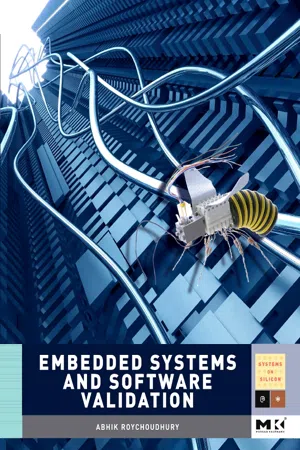
- 272 pages
- English
- PDF
- Available on iOS & Android
eBook - PDF
Embedded Systems and Software Validation
About this book
Modern embedded systems require high performance, low cost and low power consumption. Such systems typically consist of a heterogeneous collection of processors, specialized memory subsystems, and partially programmable or fixed-function components. This heterogeneity, coupled with issues such as hardware/software partitioning, mapping, scheduling, etc., leads to a large number of design possibilities, making performance debugging and validation of such systems a difficult problem.
Embedded systems are used to control safety critical applications such as flight control, automotive electronics and healthcare monitoring. Clearly, developing reliable software/systems for such applications is of utmost importance. This book describes a host of debugging and verification methods which can help to achieve this goal.
- Covers the major abstraction levels of embedded systems design, starting from software analysis and micro-architectural modeling, to modeling of resource sharing and communication at the system level
- Integrates formal techniques of validation for hardware/software with debugging and validation of embedded system design flows
- Includes practical case studies to answer the questions: does a design meet its requirements, if not, then which parts of the system are responsible for the violation, and once they are identified, then how should the design be suitably modified?
Frequently asked questions
Yes, you can cancel anytime from the Subscription tab in your account settings on the Perlego website. Your subscription will stay active until the end of your current billing period. Learn how to cancel your subscription.
At the moment all of our mobile-responsive ePub books are available to download via the app. Most of our PDFs are also available to download and we're working on making the final remaining ones downloadable now. Learn more here.
Perlego offers two plans: Essential and Complete
- Essential is ideal for learners and professionals who enjoy exploring a wide range of subjects. Access the Essential Library with 800,000+ trusted titles and best-sellers across business, personal growth, and the humanities. Includes unlimited reading time and Standard Read Aloud voice.
- Complete: Perfect for advanced learners and researchers needing full, unrestricted access. Unlock 1.4M+ books across hundreds of subjects, including academic and specialized titles. The Complete Plan also includes advanced features like Premium Read Aloud and Research Assistant.
We are an online textbook subscription service, where you can get access to an entire online library for less than the price of a single book per month. With over 1 million books across 1000+ topics, we’ve got you covered! Learn more here.
Look out for the read-aloud symbol on your next book to see if you can listen to it. The read-aloud tool reads text aloud for you, highlighting the text as it is being read. You can pause it, speed it up and slow it down. Learn more here.
Yes! You can use the Perlego app on both iOS or Android devices to read anytime, anywhere — even offline. Perfect for commutes or when you’re on the go.
Please note we cannot support devices running on iOS 13 and Android 7 or earlier. Learn more about using the app.
Please note we cannot support devices running on iOS 13 and Android 7 or earlier. Learn more about using the app.
Yes, you can access Embedded Systems and Software Validation by Abhik Roychoudhury in PDF and/or ePUB format, as well as other popular books in Computer Science & Digital Media. We have over one million books available in our catalogue for you to explore.
Information
Table of contents
- Front Cover
- Embedded Systems and Software Validation
- Copyright Page
- Dedication Page
- Table of Contents
- Acknowledgments
- Preface
- Chapter 1. Introduction
- Chapter 2. Model Validation
- Chapter 3. Communication Validation
- Chapter 4. Performance Validation
- Chapter 5. Functionality Validation
- Bibliography
- Index